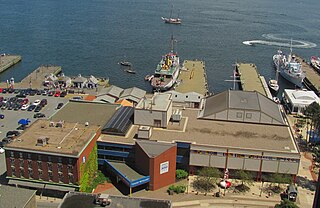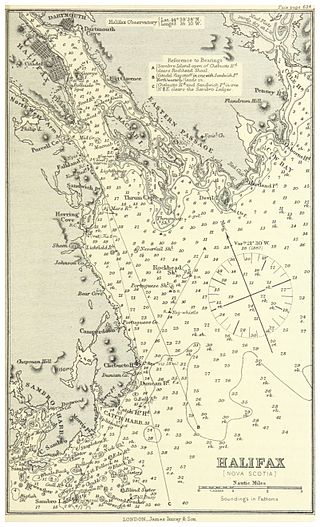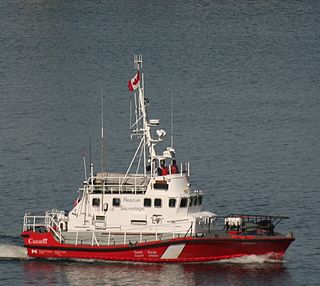Sambro Head is a community of the Halifax Regional Municipality, Nova Scotia located between Ketch Harbour and Sambro on the Chebucto Peninsula on Nova Scotia Route 349.
Sambro Head is a community of the Halifax Regional Municipality, Nova Scotia located between Ketch Harbour and Sambro on the Chebucto Peninsula on Nova Scotia Route 349.
Canadian Maritime Engineering operates a small shipyard in Sambro Head maintaining mostly smaller vessels but the yard was originally responsible for repairs to CCGS Corporal McLaren M.M.V..

The Maritime Museum of the Atlantic is a maritime museum located in downtown Halifax, Nova Scotia, Canada.
The Mayflower Curling Club, was established in 1905. Since 1962 the club has been located at 3000 Monaghan Drive in Nova Scotia's Halifax Regional Municipality.

Halifax Harbour is a large natural harbour on the Atlantic coast of Nova Scotia, Canada, located in the Halifax Regional Municipality. Halifax largely owes its existence to the harbour, being one of the largest and deepest ice-free natural harbours in the world. Before Confederation it was one of the most important commercial ports on the Atlantic seaboard. In 1917, it was the site of the world's largest man-made accidental explosion, when the SS Mont-Blanc blew up in the Halifax Explosion of December 6.

The Downtown Halifax Link system is a network of climate-controlled pedways connecting various office buildings, hotels, parkades, and entertainment venues around downtown Halifax, Nova Scotia, Canada. It is similar to Toronto's PATH or Montreal's RÉSO system, but on a much smaller scale. These walkways are all open to the public, and are convenient during inclement weather and the winter months.
Grand Lake can refer to at least 9 different lakes in the Canadian province of Nova Scotia:

The Halifax Regional Police (HRP) is one of a number of law enforcement agencies operating in the Halifax, Nova Scotia; the other primaries being the Royal Canadian Mounted Police and the Canadian Forces Military Police. The city also is home to a small detachment of the Canadian National Railway Police.

Long Lake Provincial Park is located in Halifax, Nova Scotia, Canada. It was initiated in 1981 by then Premier John Buchanan after Halifax's water supply had been shifted from the Spruce Hill/Long Lake/Chain Lakes watershed to the Pockwock Lake watershed near Hammonds Plains. The 2,095-hectare (5,180-acre) park, formally established in 1984, constitutes the bulk of these former watershed lands. Other portions were deeded to the municipality of Halifax, and the area around the Chain Lakes is still administered by the Halifax Regional Water Commission, since the Chain Lakes remain the city's emergency water supply.
Route 318 is a collector road in the Canadian province of Nova Scotia.
Route 349 is collector road in the Canadian province of Nova Scotia.

Sambro is a rural fishing community on the Chebucto Peninsula in the Halifax Regional Municipality, in Nova Scotia, Canada.
West Pennant is a rural community located at the head of Pennant Harbour near Sambro on the Chebucto Peninsula in the Halifax Regional Municipality Nova Scotia on Route 349 West Pennant is an old fishing community that sits on Fawson and Long Coves that open into Pennant Harbour. There are nearby islands: Martin Island, Powers Island, and Pennant Island. Powers Island is privately owned. Once Mi'k Maq hunting and fishing grounds, West Pennant has been occupied by three dominant colonial families since the mid 1700s: the Marriotts, Grays, and Toughs. Just 25 minutes from Halifax, West Pennant is evolving into a suburb of Halifax with many local residents moving in from other parts of Canada and overseas. Until the 1970s most families earned their living fishing, now most families have one or more members who work in Halifax-Dartmouth. West Pennant is also home to cottagers. The local corner store is Mishoo's Right Stop. West Pennant is only a few kilometres from Crystal Crescent Beach Provincial park, a unique beach flanked with granite outcrops and white sand beaches. West Pennant also borders Terrance Bay Wilderness area. Local wildlife include porcupines, deer, coyotes, bobcat, black bear, pheasant, partridge, bald eagles, golden eagles, herring gulls, osprey, beaver, moles, shrew, monarch butterfly (seasonal), raccoon, mink, muskrat, otter, harbour seals, blue jays, american goldfinch, american robin, hummingbirds (seasonal), bobcat, and possibly cougar, and right whale. Fishing is a common occupation and hobby. The dominant species caught in Pennant Harbour are Atlantic Cod, Mackerel, Boston Blue Fish, and further out, Halibut, Swordfish, and Haddock. Squid can be caught off of the government wharf in Sambro during summer nights. There is also a commercial fishery for lobster. Once the poor man's food, lobster is now a local delicacy.
Pennant Point is a rural community located at the head of Pennant Harbour near Sambro on the Chebucto Peninsula in the Halifax Regional Municipality Nova Scotia on Route 349.
Halifax was a provincial electoral district in Nova Scotia, Canada, that elected three, and then five members to the Nova Scotia House of Assembly. It existed from 1867 to 1933, at which point Halifax County was divided into five separate electoral districts: Halifax South, Halifax Centre, Halifax North, Halifax East and Halifax West.

Sambro Island Lighthouse is a landfall lighthouse located at the entrance to Halifax Harbour, Nova Scotia, on an island near the community of Sambro in the Halifax Regional Municipality. It is the oldest surviving lighthouse in North America and its construction is a National Historic Event.

CCGS Sambro is a Canadian Coast Guard motor lifeboat homeported in Sambro, Nova Scotia.
Bald Rock is a rural community of the Halifax Regional Municipality in the Canadian province of Nova Scotia on Cape Sambro on the southeast shore of the Chebucto Peninsula.
Sambro Creek is a community of the Halifax Regional Municipality in the Canadian province of Nova Scotia on the Chebucto Peninsula.
Leiblin Park, Nova Scotia is a residential neighbourhood in Halifax on the Mainland Halifax within the Halifax Regional Municipality, Nova Scotia.

Cambridge Military Library is a library building in Royal Artillery Park in Halifax, Nova Scotia, Canada which was built in 1886. The building was created to house the garrison library collection, which had been moved from various locations in the city since its creation in 1817. It is the oldest non-university public library collection in Canada. This building was the social and literary centre of military Halifax. In 1902, the officers of the garrison requested the library be named after the Prince George, Duke of Cambridge.

The Black-Binney House was a former residence built in 1819 in Halifax, Nova Scotia which is now a National Historic Site of Canada. The house was built by John Black (merchant) and is reflective of the Palladian-inspired residences common during the late 18th and early 19th centuries in Eastern Canada. In 1857, Hibbert Binney subdivided the property to build the St. Matthew's United Church (Halifax). In 1965 Sidney Culverwell Oland purchased and renovated the building to house the Nova Scotia Division of the Canadian Corps of Commissionaires.
44°29′5.1″N63°34′59.1″W / 44.484750°N 63.583083°W